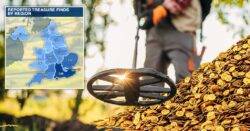A record-breaking number of discoveries were made in Britain in 2022 (Picture: Getty)
The locations where buried treasure hunters are most likely to strike it lucky have been revealed.
A record-breaking 1,378 discoveries were made in Britain in 2022 – the ninth year in a row which saw finds exceed 1,000, according to provisional data.
If confirmed, this will be the highest number since the records began, when the Treasure Act came into effect in 1996.
The figure is up from 1,072 across England, Wales and Northern Ireland in 2021.
Norfolk was crowned the best spot to strike gold, with 95 discoveries in 2022, up from 85 the previous year.
Hampshire followed with 83, with 81 treasures found in Kent.
Suffolk – home to Sutton Hoo, where Anglo-Saxon treasures described as the ‘greatest archaeological discoveries of all time’ were found – is fourth on the list with 75 last year.
North Yorkshire, Wiltshire and Swindon, Lincolnshire, Essex and Shropshire follow.
South-east England remains the country’s buried treasure capital – with 349 discoveries reported last year (Picture: metro.co.uk)
Regional data shows the south-east of England remains the best area to find buried treasure region – with 349 discoveries reported last year, up from 264 in 2021.
There were 272 in East Anglia, 200 in the South West and 140 in the West Midlands.
In Wales 76 buried treasure finds were reported, while 10 were unearthed in Northern Ireland.
The 1,072 reported discoveries in 2021 equated to 860 artefacts and 212 coins.
Almost all – 1,024 – were unearthed by metal detecting, which experienced a big surge in popularity during and after the pandemic.
To view this video please enable JavaScript, and consider upgrading to a web
browser that
supports HTML5
video
Around a third of the total were dated to the post-medieval period (15th to 18th century), while a quarter are said to have been buried in the medieval period (5th to 15th century), Mail Online reports.
The treasures included Roman coins, Bronze Age artefacts and some items dating back to the Iron Age.
Under the Treasure Act in 1996, people who find potential treasure are obligated to report their discoveries to a local coroner within two weeks.
The act defines treasure as prehistoric objects, coins that contain at least 10 per cent gold or silver and are at least 300 years old.
Metal detectorists made a record 1,378 discoveries in Britain last year (Picture: metro.co.uk)
It also includes more recent valuable objects that have been deliberately hidden.
Items found on or after July 30 this year may qualify if they are made partially of metal, at least 200 years old, and provided ‘exceptional insight into an aspect of national or regional history, archaeology, or culture.
Just 54 finds were recorded in 1997, a year after the Treasure Act was established.
The number of finds in 2022 will be officially confirmed in the Treasure Finds Statistical Release in 2024, which will also include the provisional figures for 2023.
Get in touch with our news team by emailing us at [email protected].
For more stories like this, check our news page.
A record-breaking number of discoveries were made in Britain last year – as metal detecting experienced a surge in popularity during and after the pandemic.




